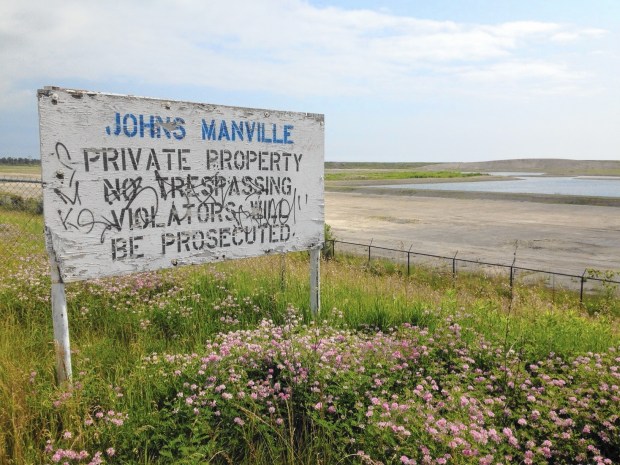Citing concerns of asbestos-contaminated material surfacing adjacent to the infamous Johns Manville site due to a freeze and thaw cycle, the EPA held a public meeting in Waukegan on Wednesday sharing proposals to best monitor and clean the 1-acre area.
A few dozen residents and local officials gathered at Waukegan City Hall for the presentation by David Nadel, remedial project manager with the EPA. A public comment period on the proposed plan will run until June 27.
The Johns Manville site, about 350 acres sitting along Lake Michigan, was once home to a manufacturing facility that contaminated the area with asbestos. Johns-Manville ceased operations on the site in 1998, according to the EPA, and its former manufacturing buildings were demolished in 2000 and 2001.
Today, it’s one of five Superfund sites in Waukegan, areas that the federal government recognizes as especially hazardous and manages cleanup efforts. The area discussed on Wednesday is a relatively small, roughly 1-acre section that is within the Illinois Beach Nature Preserve, known as Operable Unit 6, or OU6.
Representatives of the EPA emphasized during the meeting that the areas in question are not readily accessible to residents, and area neighborhoods are not at risk of exposure.
Material contaminated with asbestos was discovered and removed from a road in OU6 in 1998, but more fragments were found the following year. The freeze and thaw cycle of the area was causing the contaminated material to come to the surface, Nadel said.
This is especially dangerous because weathering can cause the asbestos to become more “friable,” he said, meaning it can be more easily broken down and spread.
Two potential action plans were presented. The first, estimated to cost $554,000, consisted of “periodic manual removal” of asbestos contamination and disposal at an approved facility. This would also include visual monitoring, maintaining existing access restrictions, land-use control and maintaining existing fencing at the property line.
However, that option doesn’t “provide adequate warning to authorized users or trespassers” of the hazards, according to Nadel, and lacks measures to evaluate effectiveness beyond visual monitoring.
The second proposed plan, which is estimated to cost $967,000, would expand on the previous plan, including enhanced monitoring, additional access control and new signage, among various other efforts. The EPA considered the second the “most effective remedy in the long term.”
Concerns over communication, controlled burns
Residents shared comments and concerns during the meeting. One, pointing to the area’s sizable Spanish-speaking community, asked if there would be translations of communications offered going forward. An EPA representative responded positively to the recommendation during the meeting.
OU6 is subject to controlled burns, and residents discussed what risks those could pose for the area. While Nadel said they had found asbestos air contamination increased during burns, it remained under what is considered the safe limit.
Some were concerned about the future of the site, noting the decades of work already done and questioning when the site will be safe. Lake County Board member Mary Ross-Cunningham, whose district includes the site and who attended the meeting, said she hoped it would one day be determined to be clean sooner rather than later.
“That’ll be a big hit for Waukegan residents,” Ross-Cunningham said.
She voiced her support for the cleanup proposal and praised the EPA for its continuing work to monitor and clean the site.




